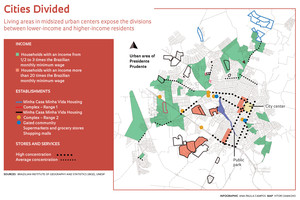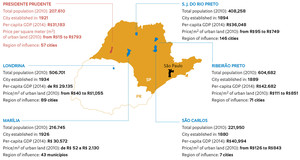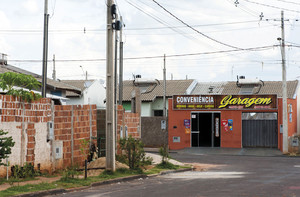
Léo Ramos Chaves
A housing complex built as part of the Minha Casa Minha Vida program for middle-income residents close to downtown Presidente PrudenteLéo Ramos ChavesPresidente Prudente—a city with 230,000 residents located 558 kilometers (km) from the state capital—seems to be segregating itself as groups of residents of higher and lower incomes close themselves within their respective spaces. Other midsized cities in the state of São Paulo, which are defined as those with 100,000 to 600,000 residents and which often serve as regional hubs with influence over dozens of nearby cities and towns, are experiencing the same phenomenon, according to studies performed in recent years by a team of researchers from São Paulo State University (UNESP).
Those who travel north from downtown President Prudente will notice lands occupied by rural properties, which seem to represent the outskirts of town, but that is not the case. Further north, there are dozens of rows of duplex dwellings. They are part of a low-income housing complex built under the Brazilian government’s Minha Casa Minha Vida program. The 2,600 houses, home to approximately 8,000 residents, were inaugurated in 2015. Begun in 2009, the Minha Casa Minha Vida program (which literally translates to “My House, My Life”) became the largest Brazilian housing project program in the past 30 years, with almost R$300 billion invested and 10.5 million beneficiaries as of October 2016.
 Up close, differences in the houses become more apparent: complementary programs offering credit for the purchase of building materials have enabled the construction of high walls and gates that completely isolate the area, while other houses remain exposed. Signs for markets, bars, and beauty salons line the entrances to the houses, even without legal permission for business activities. The treeless landscape is marked by the yellow tower of a school, which itself is surrounded by walls and an electric fence.
Up close, differences in the houses become more apparent: complementary programs offering credit for the purchase of building materials have enabled the construction of high walls and gates that completely isolate the area, while other houses remain exposed. Signs for markets, bars, and beauty salons line the entrances to the houses, even without legal permission for business activities. The treeless landscape is marked by the yellow tower of a school, which itself is surrounded by walls and an electric fence.
To the south, 9 km from the complex, there is a set of high-end gated communities surrounded by four-meter-high walls lined with electric fences. “In the interviews we carried out, the residents reported that their biggest concern was safety, but they acknowledged that they sought social distinction through their housing choice,” explains geographer Arthur Whitacker, professor at the School of Science and Technology (FCT) of UNESP’s Presidente Prudente campus. Neither houses nor people can be seen from the street—only long walls. High walls with barbed wire also surround the groups of buildings for middle-income residents that make up the Minha Casa Minha Vida program closer to the center of the city.
 These complexes and gated communities have contributed to the widening of the urban area. In an article published this year in Mercator magazine from the Federal University of Ceará (UFC), French geographer Hervé Théry, visiting professor from the University of São Paulo (USP), observed that the Minha Casa Minha Vida program led to the formation of the largest neighborhoods in cities such as Ponta Porã (Mato Grosso do Sul) and Sobral (Ceará).
These complexes and gated communities have contributed to the widening of the urban area. In an article published this year in Mercator magazine from the Federal University of Ceará (UFC), French geographer Hervé Théry, visiting professor from the University of São Paulo (USP), observed that the Minha Casa Minha Vida program led to the formation of the largest neighborhoods in cities such as Ponta Porã (Mato Grosso do Sul) and Sobral (Ceará).
Other researchers agree. “These gated communities catering to people of distinct income ranges are set up as if there were many cities within one, since the residents of each one rarely interact with residents from the others,” summarizes geographer Maria Encarnação Sposito, professor at UNESP and coordinator of a multidisciplinary team that has studied changes in midsized cities. Sposito explains that socio-spatial separation—first examined in Brazil by geographer Milton Santos (1926-2001) in the 1980s in his studies on metropolises—has recently intensified due to the decrease in communal spaces shared by different social classes. Examples of these spaces include streets in city centers, which today are generally occupied by lower-income residents.

LÉO RAMOS CHAVES
Local school (yellow tower) and low-income housing in northern Presidente PrudenteLÉO RAMOS CHAVESTo demonstrate the reach of this phenomenon, Sposito refers to the maps from the six cities studied by her group since 2012: Presidente Prudente, Ribeirão Preto, São José do Rio Preto, Marília, São Carlos (which are located in the state of São Paulo), and Londrina (in Paraná). These cities were chosen because of their historical and economic similarities: all six were established around the coffee industry in the early twentieth century. The maps created based on the 2010 Brazilian Census and on the group’s field surveys provide evidence of concentrations of lower-income housing complexes and more densely populated areas in the northern regions of the cities and of wealthier neighborhoods in the southern regions of the cities in the cases of Presidente Prudente, Ribeirão Preto, São José do Rio Preto, Marília, and Londrina. The opposite has occurred in the city of São Carlos: the wealthier neighborhoods are located in the north, and the poorer neighborhoods are located in the south. In addition, the division is not as clear there, “though sectioning is being integrated through the construction of new high-end gated communities,” Sposito explains.
In addition, three architects—Bárbara Siqueira, professor at Extremo Sul Catarinense University (UNESC), Sandra Silva, and Ricardo Silva, professors at the Federal University of São Carlos (UFSCAR)—examined urban occupation in São Carlos and São José do Rio Preto from 1970 to 2010. In support of the UNESP researchers’ conclusions, they found that gated communities reinforce “social and spatial fragmentation processes on urban borders through the establishment of large walled spaces and through the horizontal and discontinuous spread of cities,” as reported in their 2016 article published in the journal Revista Políticas Públicas & Cidades (Public Policies and Cities Journal).

LÉO RAMOS CHAVES
Walls and gates around houses…LÉO RAMOS CHAVESUrban Insecurity
The results of studies by the UNESP group have indicated significant involvement of real estate companies in determining the areas to be occupied by new housing projects and complexes. Meanwhile, the residents feel protected from urban violence after moving into gated communities and proud to be able to buy their own houses. “Regardless of their socioeconomic group, the residents we interviewed consistently reported an underlying feeling of insecurity, as if urban violence were everywhere and not restricted to specific times or areas,” says historian Eda Góes, the UNESP professor who coordinated the interviews. “The idea of urban insecurity supports the ideal of living in a gated community,” she continues. According to Góes, this growing socio-spatial separation represents “a rejection of the city as a common collective space, which is the essence of urban living.”
Sposito, Góes, and other researchers from the group have identified the likely consequences of this socio-spatial segregation: an increase in the value placed on private spaces and a decrease in the value placed on public spaces, such as the city center and plazas; the emptying of city streets, which increasingly become areas for mere circulation, rather than for social gathering; a surge in social stereotypes about richer groups and poorer groups; and the strengthening of new mechanisms involved in the development of urban space. In the past, Sposito notes, the formation of a commercial or residential area was the result of the initiative of small business owners, local government, and residents.

LÉO RAMOS CHAVES
… and businesses: concern over safety is common in all socioeconomic classesLÉO RAMOS CHAVES“Today, the development of urban spaces and the expansion of cities are largely governed by real estate companies which, with the support of local governments, decide where to build gated communities and shopping malls, decisions which quickly establish where commerce will take place,” says Sposito. Economist Everaldo Melazzo, a professor at UNESP who analyzed the role of real estate companies, adds the following: “Real estate companies choose which areas will be occupied, and based on their pricing, the social groups which will occupy them.” Melazzo highlights the limits of this system of expansion and occupation in cities, one which is no longer questioned: “Private capital alone cannot organize cities or create social life. Public policies are fundamental for organizing and qualifying the development of urban spaces.”
Identification or Discomfort
In Brazil’s most recent expansion process, which began to take off in the 1960s, shopping malls have reinforced social separation by creating private spaces for leisure and consumption which are focused on specific socioeconomic groups. In an article published in the Portuguese journal Finisterra, Góes argues that shopping malls work to make certain visitors feel more or less comfortable and select for certain groups through the use of marketing that generates identification or discomfort, through the number and disposition of the guards, and through the use of security cameras. Góes spotted 50 cameras in the mall known as Prudenshopping and 16 in the Parque Shopping mall. The latter was built downtown in 1989 to target a lower-income market. According to the professor, surveillance systems reflect a practice of social scrutiny that may even be desired by shoppers, since these systems highlight “a supposed efficacy on the part of the market to respond to problems that the state has shown to be unable to resolve, such as public safety.”

LÉO RAMOS CHAVES
The outer wall of a high-end gated community…LÉO RAMOS CHAVESShopping malls have quickly transformed city centers by attracting stores meant for wealthier consumers or by inducing the adaptation of individual stores to suit clients with less purchasing power. “Retail stores try to find their own niches in the market,” explains UNESP professor Eliseu Sposito, who studied the consequences of the arrival of large chain stores selling home appliances in midsized cities. He also observed changes in retail stores in the city of Chapecó, in Santa Catarina State, one of the 18 cities studied by 43 researchers from the Network of Midsized Cities (RECIME), a research group involving 17 universities from Brazil, two from Chile, and one from Argentina. The studies from the Research Group on the Production of Space and Regional Redefinitions (GASPERR) of UNESP, as well as other studies from the RECIME, have helped scholars to understand the processes and rhythms of transformation within midsized cities.
Made up of 18 researchers and more than 50 students, the UNESP research group interviewed residents of the six cities between 2012 and 2016 in order to investigate changes in their consumption habits and the impact of the arrival of large chain stores, which have created new shopping centers. As a result of these new retail outlets, “downtown areas in midsized cities have lost their social prestige and have become increasingly lower class, but they haven’t died out completely,” says Whitacker. With many stores playing music at the entrances at the same time, the streets downtown allow for a level of expression and spontaneity rarely permitted in shopping malls. “The city’s protests and demonstrations happen here,” says Melazzo as he walks to an area known as “the shopping mall for the masses,” a series of booths and tents selling products on the informal market.

LÉO RAMOS CHAVES
…and upscale family dwellings, both in southern Presidente PrudenteLÉO RAMOS CHAVESAt six o’clock in the evening, however, the stores close and the streets go quiet. Neighborhood movie theaters, such as Presidente Prudente’s Cine Presidente, faded out in the 1990s. “The city center is merely a commercial center; it is no longer the center of residents’ social lives,” concludes geographer Nécio Turra Neto, a professor at UNESP who studies changes in nightlife in Presidente Prudente. This nightlife includes bars, clubs, and dance halls, which today are centered around the avenues close to Prudenshopping.
Project
Economic logic and contemporary spatial practices: Midsized cities and consumption (nº 11/20155-3); Grant Mechanism Thematic Project; Principal Investigator Maria Encarnação Beltrão Sposito (UNESP); Investment R$3,646,985.87.
Scientific articles
GÓES, E. Shopping center: Consumo, simulação e controle social. Finisterra. V. 51, No. 102, p. 65-80. 2016.
SIQUEIRA, B. V. et al. Novas configurações em periferias de cidades médias paulistas: A proliferação dos empreendimentos habitacionais com controle de acesso. Revista Políticas Públicas & Cidades. V. 4, No. 1, p. 69-92. 2016.
THÉRY, H. Novas paisagens urbanas do programa Minha Casa Minha Vida. Mercator. V. 16, e16002, p. 1-14. 2017.

